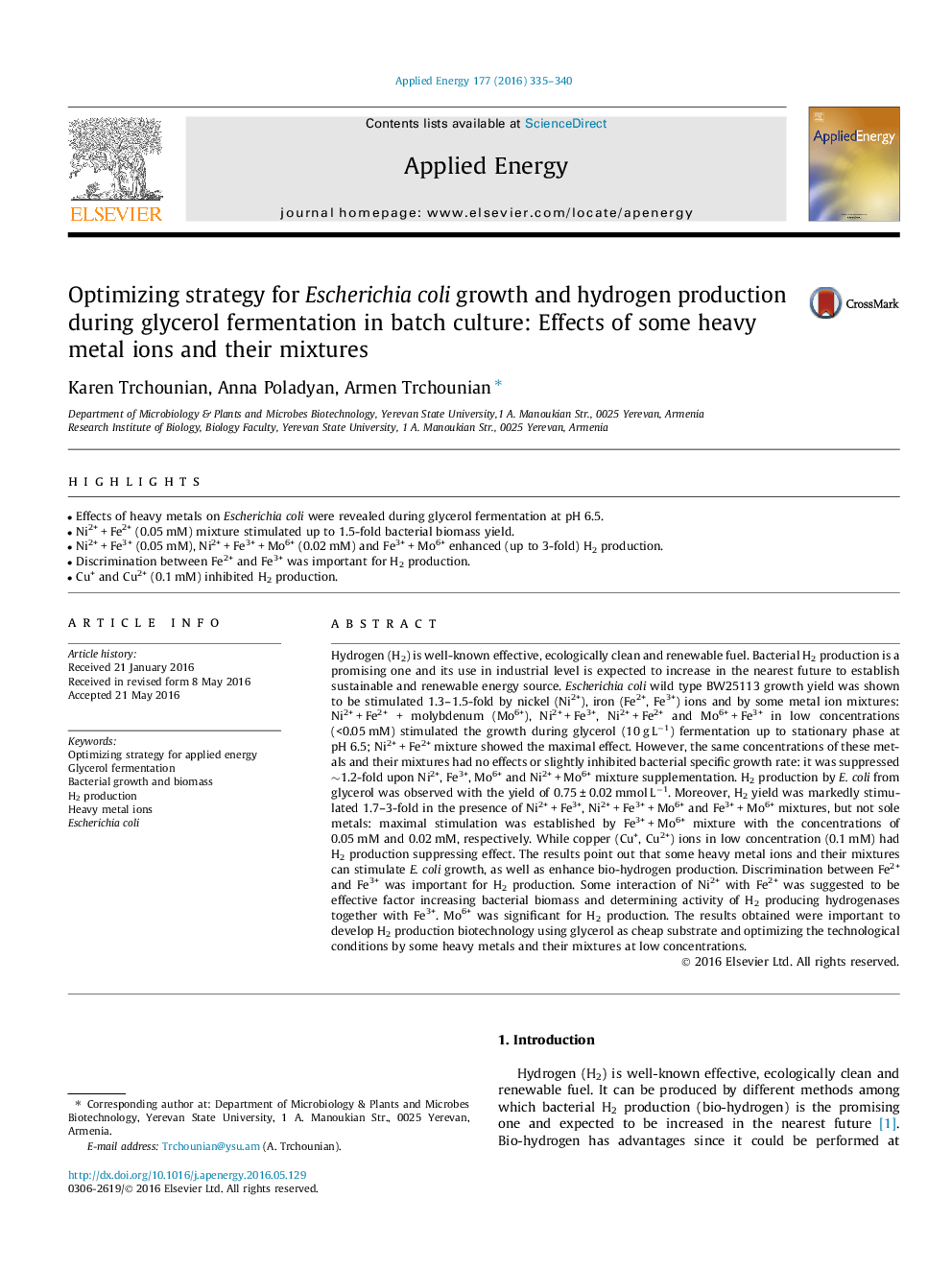| کد مقاله | کد نشریه | سال انتشار | مقاله انگلیسی | نسخه تمام متن |
|---|---|---|---|---|
| 6682708 | 501851 | 2016 | 6 صفحه PDF | دانلود رایگان |
عنوان انگلیسی مقاله ISI
Optimizing strategy for Escherichia coli growth and hydrogen production during glycerol fermentation in batch culture: Effects of some heavy metal ions and their mixtures
دانلود مقاله + سفارش ترجمه
دانلود مقاله ISI انگلیسی
رایگان برای ایرانیان
کلمات کلیدی
موضوعات مرتبط
مهندسی و علوم پایه
مهندسی انرژی
مهندسی انرژی و فناوری های برق
پیش نمایش صفحه اول مقاله

چکیده انگلیسی
Hydrogen (H2) is well-known effective, ecologically clean and renewable fuel. Bacterial H2 production is a promising one and its use in industrial level is expected to increase in the nearest future to establish sustainable and renewable energy source. Escherichia coli wild type BW25113 growth yield was shown to be stimulated 1.3-1.5-fold by nickel (Ni2+), iron (Fe2+, Fe3+) ions and by some metal ion mixtures: Ni2+ + Fe2+ + molybdenum (Mo6+), Ni2+ + Fe3+, Ni2+ + Fe2+ and Mo6+ + Fe3+ in low concentrations (<0.05 mM) stimulated the growth during glycerol (10 g Lâ1) fermentation up to stationary phase at pH 6.5; Ni2+ + Fe2+ mixture showed the maximal effect. However, the same concentrations of these metals and their mixtures had no effects or slightly inhibited bacterial specific growth rate: it was suppressed â¼1.2-fold upon Ni2+, Fe3+, Mo6+ and Ni2+ + Mo6+ mixture supplementation. H2 production by E. coli from glycerol was observed with the yield of 0.75 ± 0.02 mmol Lâ1. Moreover, H2 yield was markedly stimulated 1.7-3-fold in the presence of Ni2+ + Fe3+, Ni2+ + Fe3+ + Mo6+ and Fe3+ + Mo6+ mixtures, but not sole metals: maximal stimulation was established by Fe3+ + Mo6+ mixture with the concentrations of 0.05 mM and 0.02 mM, respectively. While copper (Cu+, Cu2+) ions in low concentration (0.1 mM) had H2 production suppressing effect. The results point out that some heavy metal ions and their mixtures can stimulate E. coli growth, as well as enhance bio-hydrogen production. Discrimination between Fe2+ and Fe3+ was important for H2 production. Some interaction of Ni2+ with Fe2+ was suggested to be effective factor increasing bacterial biomass and determining activity of H2 producing hydrogenases together with Fe3+. Mo6+ was significant for H2 production. The results obtained were important to develop H2 production biotechnology using glycerol as cheap substrate and optimizing the technological conditions by some heavy metals and their mixtures at low concentrations.
ناشر
Database: Elsevier - ScienceDirect (ساینس دایرکت)
Journal: Applied Energy - Volume 177, 1 September 2016, Pages 335-340
Journal: Applied Energy - Volume 177, 1 September 2016, Pages 335-340
نویسندگان
Karen Trchounian, Anna Poladyan, Armen Trchounian,